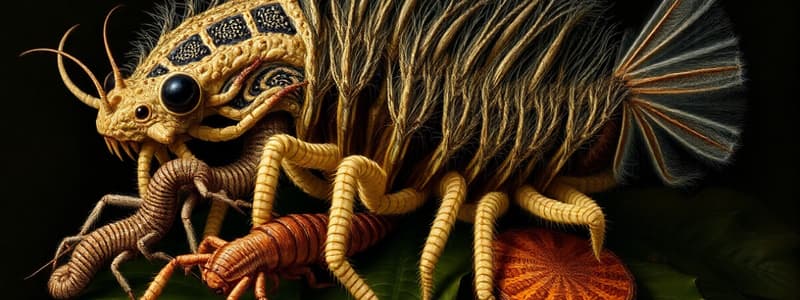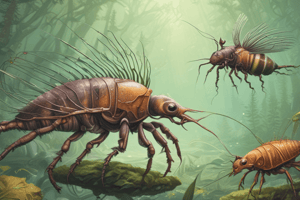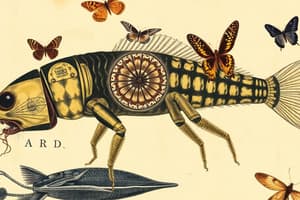Podcast
Questions and Answers
What percentage of animals are estimated to be invertebrates?
What percentage of animals are estimated to be invertebrates?
- 85%
- 75%
- 99% (correct)
- 90%
All known animal phyla have been discovered as of now.
All known animal phyla have been discovered as of now.
False (B)
What significant paleontological discovery did Charles Walcott make in 1909?
What significant paleontological discovery did Charles Walcott make in 1909?
Burgess Shale
The estimated number of described animal species is ________ million.
The estimated number of described animal species is ________ million.
What is the main focus of Dr. Amy Moran's teaching?
What is the main focus of Dr. Amy Moran's teaching?
Students are required to have a textbook for the course.
Students are required to have a textbook for the course.
How many exams contribute to the lecture grade?
How many exams contribute to the lecture grade?
Students should complete the 'Weekly Engagement' on Laulima by _____ PM on January 21.
Students should complete the 'Weekly Engagement' on Laulima by _____ PM on January 21.
Match the following TAs with their respective codes:
Match the following TAs with their respective codes:
What percentage of the lecture grade is based on in-class activities?
What percentage of the lecture grade is based on in-class activities?
Students can share photos and materials without permission from instructors.
Students can share photos and materials without permission from instructors.
What major questions does the course aim to answer regarding invertebrates?
What major questions does the course aim to answer regarding invertebrates?
Which of the following is NOT a characteristic of living organisms?
Which of the following is NOT a characteristic of living organisms?
Epithelial tissue functions to connect different environments.
Epithelial tissue functions to connect different environments.
What grade of organization consists of one or more types of cells working together?
What grade of organization consists of one or more types of cells working together?
Homeostasis involves maintaining a __________ state.
Homeostasis involves maintaining a __________ state.
What becomes more complicated as an organism increases in size?
What becomes more complicated as an organism increases in size?
Match the levels of organization with their descriptions:
Match the levels of organization with their descriptions:
Metazoans only consist of single-celled organisms.
Metazoans only consist of single-celled organisms.
In the context of size and complexity, it is said that the bigger an organism is, the more __________ it has to be.
In the context of size and complexity, it is said that the bigger an organism is, the more __________ it has to be.
Which of the following correctly identifies the hierarchical levels of classification in Linnaeus' system?
Which of the following correctly identifies the hierarchical levels of classification in Linnaeus' system?
Carolus Linnaeus described over 5,000 species in his work.
Carolus Linnaeus described over 5,000 species in his work.
What is the main focus of the hierarchical classification developed by Linnaeus?
What is the main focus of the hierarchical classification developed by Linnaeus?
Linnaean classification is considered outdated as newer methods use __________ trees.
Linnaean classification is considered outdated as newer methods use __________ trees.
Match the following domains of life with their descriptions:
Match the following domains of life with their descriptions:
Which of the following terms refers to the shared derived characteristics used in classification?
Which of the following terms refers to the shared derived characteristics used in classification?
The term __________ refers to unicellular eukaryotes that are genetically and morphologically diverse.
The term __________ refers to unicellular eukaryotes that are genetically and morphologically diverse.
What is the significance of the term 'plan' in relation to phylum classification?
What is the significance of the term 'plan' in relation to phylum classification?
Which of these factors limits the effectiveness of diffusion as a means of supplying oxygen to large organisms?
Which of these factors limits the effectiveness of diffusion as a means of supplying oxygen to large organisms?
Respiratory pigments, such as hemoglobin and hemocyanin, increase the oxygen-carrying capacity of the blood by binding to oxygen molecules.
Respiratory pigments, such as hemoglobin and hemocyanin, increase the oxygen-carrying capacity of the blood by binding to oxygen molecules.
What is the primary function of a circulatory system in animals?
What is the primary function of a circulatory system in animals?
The evolution of a ______ system in animals was a key adaptation for efficient oxygen transport to internal tissues.
The evolution of a ______ system in animals was a key adaptation for efficient oxygen transport to internal tissues.
Match the following respiratory pigments with the animal groups they are commonly found in.
Match the following respiratory pigments with the animal groups they are commonly found in.
The rate of diffusion is much faster in water than in air.
The rate of diffusion is much faster in water than in air.
Which of these adaptations is NOT a strategy for increasing surface area to volume ratio in animals to improve oxygen transport?
Which of these adaptations is NOT a strategy for increasing surface area to volume ratio in animals to improve oxygen transport?
How does the surface area to volume ratio change as an organism grows larger?
How does the surface area to volume ratio change as an organism grows larger?
The evolution of collagen, a structural protein, played a significant role in the development of ______ in animals.
The evolution of collagen, a structural protein, played a significant role in the development of ______ in animals.
Which of the following is a key difference between the life cycles of animals (Metazoa) and protists (Protozoa)?
Which of the following is a key difference between the life cycles of animals (Metazoa) and protists (Protozoa)?
Flashcards
Invertebrates
Invertebrates
Animals without a backbone, encompassing diverse species.
Biodiversity
Biodiversity
The variety of life in the world or a particular habitat.
Metazoans
Metazoans
Multicellular organisms distinguished from unicellular organisms.
Ecological Physiology
Ecological Physiology
Signup and view all the flashcards
Larval Biology
Larval Biology
Signup and view all the flashcards
Exam Structure
Exam Structure
Signup and view all the flashcards
Respectful Classroom
Respectful Classroom
Signup and view all the flashcards
Weekly Engagement
Weekly Engagement
Signup and view all the flashcards
Morphological Diversity
Morphological Diversity
Signup and view all the flashcards
Burgess Shale
Burgess Shale
Signup and view all the flashcards
Cambrian Explosion
Cambrian Explosion
Signup and view all the flashcards
Colony Niches
Colony Niches
Signup and view all the flashcards
Carolus Linnaeus
Carolus Linnaeus
Signup and view all the flashcards
Linnaean Levels of Classification
Linnaean Levels of Classification
Signup and view all the flashcards
Synapomorphies
Synapomorphies
Signup and view all the flashcards
Phylogenetic Trees
Phylogenetic Trees
Signup and view all the flashcards
Three Domains of Life
Three Domains of Life
Signup and view all the flashcards
Eukaryotes
Eukaryotes
Signup and view all the flashcards
Protozoa
Protozoa
Signup and view all the flashcards
Phylum
Phylum
Signup and view all the flashcards
Diffusion
Diffusion
Signup and view all the flashcards
Diffusion Rate in Air
Diffusion Rate in Air
Signup and view all the flashcards
Diffusion Rate in Water
Diffusion Rate in Water
Signup and view all the flashcards
Surface Area to Volume Ratio
Surface Area to Volume Ratio
Signup and view all the flashcards
Gas Exchange Surfaces
Gas Exchange Surfaces
Signup and view all the flashcards
Respiratory Pigments
Respiratory Pigments
Signup and view all the flashcards
Circulatory System
Circulatory System
Signup and view all the flashcards
Metazoan Development
Metazoan Development
Signup and view all the flashcards
Collagen
Collagen
Signup and view all the flashcards
Larval Stage Life History
Larval Stage Life History
Signup and view all the flashcards
Homeostasis
Homeostasis
Signup and view all the flashcards
Cellular respiration
Cellular respiration
Signup and view all the flashcards
Epithelial tissue
Epithelial tissue
Signup and view all the flashcards
Tissue grade organization
Tissue grade organization
Signup and view all the flashcards
Organ grade organization
Organ grade organization
Signup and view all the flashcards
Size and complexity
Size and complexity
Signup and view all the flashcards
Organismal interaction
Organismal interaction
Signup and view all the flashcards
Study Notes
Course Information
- Course Title: BIOL 485, Biology of the Invertebrates
- Course Year: Spring 2025
- Instructor: Dr. Amy Moran
- Lab Location: Edmondson 103
- Lab Schedule: Thursday/Friday (1/16 and 1/17) - no lab Tuesday/Wednesday
- Lab Materials: Lab notebook/drawing tablet, dissecting kit, gloves, field footwear (tabis recommended for field trips); kit available at the Porifera lab for initial field trip
Course Logistics
- Lectures: No textbook required; lecture notes and materials on Laulima;
- Grading: 80% exams (4 exams, 20% each - not cumulative, except for concepts carried over) ; 20% in-class activities (5 out of 6, 4% each)
- Expect approximately 6 hours per week of study time
- Questions: Ask questions during class (raise hand) or email/office hours (especially those about your grade); sharing of photos/materials only with permission; some lectures may be asynchronous
- Bookkeeping: Verify participation by completing the "Weekly Engagement" activity on Laulima by 11:55 PM on Tuesday, January 21; failure to do so may lead to administrative drop from the course
Course Questions
- What are invertebrates? How did their incredible diversity arise?
- What distinguishes major invertebrate groups from each other?
- How have very different types of animals "solved" life's major challenges?
Course Themes
- Morphological diversity
- Physiology
- Ecology
- Evolution
Biodiversity
- Approximately 99% of animals are invertebrates
- Estimated 32-35 animal phyla
-
1.5 million animal species described, with an estimated total of >30 million
Invertebrate Origins
- Charles Walcott (paleontologist) discovered rich fossil bed of ancient invertebrates in 1909 (Burgess Shale Formation, Canadian Rocky Mountains)
- Estimated age of fossils is 510 million years ago.
- Many modern phyla of animals are found in this fossil bed, consistent with the "Cambrian Explosion".
- Examples of Cambrian fossils: Anomalocaris, Pikaia, Vetulicolia, Akadocrinus
Snowball Earth Hypothesis
- Metazoans arose in the oceans after the Baykonurian glaciation snowball event, about 550 million years ago.
- This period featured: lots of space and habitats suddenly available for colonization, many available niches for life to evolve, evolved into new species.
Classification in Western Science
- Carolus Linnaeus (1700s): Created Systema Naturae, a hierarchical system of classification based on shared characteristics, describing over 9,000 species.
- Phylum: High-level classification characterized by a unique body plan (Bauplan).
Modern Classification (Phylogenetic)
- Linnaean classification is outdated, now using phylogenetic trees
- Hierarchical system based on synapomorphies (shared derived characteristics)
Three Domains of Life
- Bacteria, Archaea, Eukarya
Protists (Protozoa)
- Unicellular eukaryotes; genetically and morphologically extremely diverse
Phylum (?) Choanoflagellata
- Contains choanocytes (type cell)
Basic Living Organism Needs
- Acquire energy
- Reproduce
- Develop
- Move
- Homeostasis
- Cellular respiration
- Gas exchange
- Waste excretion
Homeostasis
- Process of maintaining a steady state in a living organism, or in components of an organism
Metazoan Cell Organization
- Cells organized into functional tissues (typically only in Eumetazoa, not Parazoa)
Grades of Organization
- Single cells (protists)
- Tissue grade (body consists of groups of similar cells performing a particular function and having a common embryonic origin)
- Organ grade (body is organized into organs with highly specialized functions)
Metazoan Size Influence
- As size increases, the organism may become more complex or need more strategies to maintain a constant internal conditions
Obtaining and Distributing Materials:
- Diffusion is a crucial process for obtaining and distributing materials from the environment only works with small organisms
- Gas exchange (air and water): diffusion through the environment into the animal body
- Large organisms require circulatory systems for efficient transport
Oxygen Supply to Internal Tissues (Limitations of Diffusion)
- High metabolic demand with increasing body size requires a complex circulatory system for efficient O2 delivery
- Diffusion slows with increasing body size/distance and demands more efficient, specialized systems for large organisms
Oxygen Binding Pigments
- Increase the oxygen-carrying capacity of solutions (i.e., blood) by up to 100 folds.
- Examples: Hemoglobin, Hemerythrin, Chlorocruorin, Hemocyanin
Metazoan Life History
- Development proceeds from a blastula via cleavage and gastrulation
- Many metazoans have a life history stage involving a larva (microscopic, planktonic) followed by a juvenile stage, eventually morphing to the adult form.
Evolutionary Relationships
- Phylogenetic tree illustrating the evolutionary relationships between Protists (Protozoa), Parazoa (lacking true tissues), and Eumetazoa (with tissues); illustrating the origins of tissues, symmetry, development from a blastula, and collagen
Studying That Suits You
Use AI to generate personalized quizzes and flashcards to suit your learning preferences.




